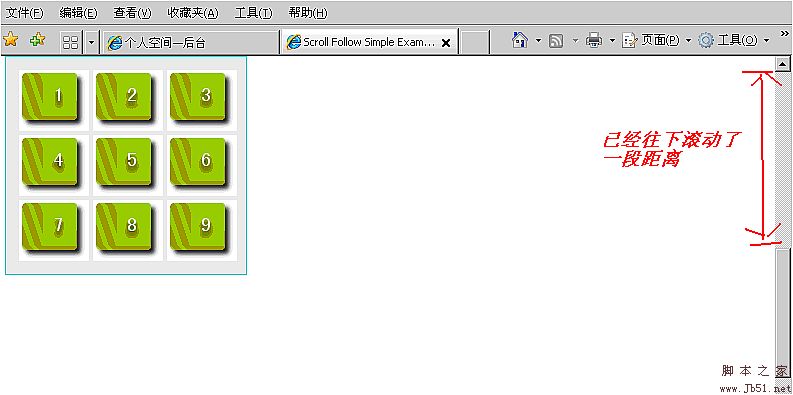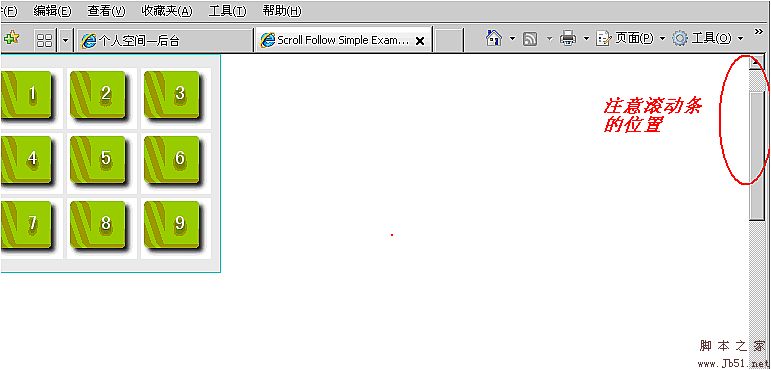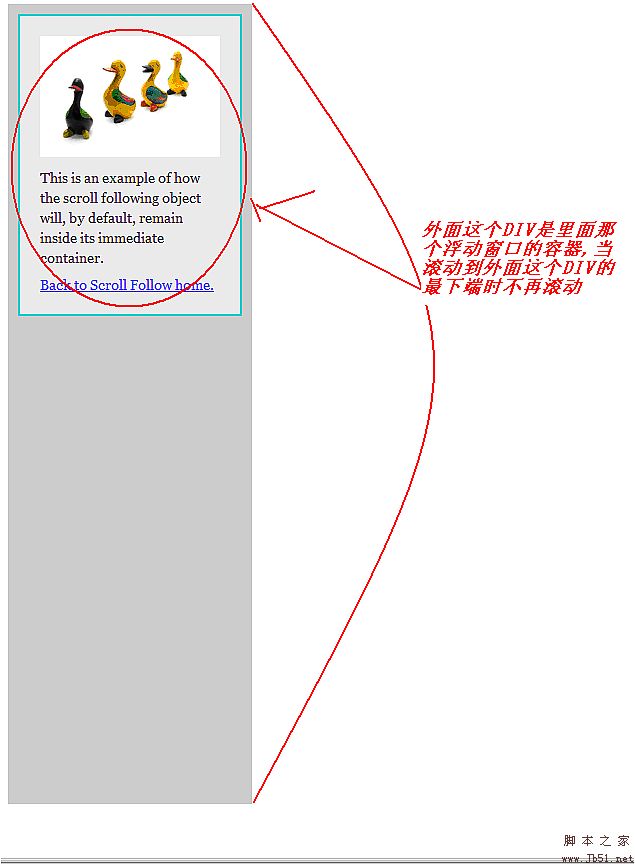 Web Front-end
Web Front-end
 JS Tutorial
JS Tutorial
 Floating window control when the page is scrolled_jquery implemented by JQuery
Floating window control when the page is scrolled_jquery implemented by JQuery
Floating window control when the page is scrolled_jquery implemented by JQuery


1. Introduction:
The effect this control can achieve is that when your page scrolls, a certain DIV will always stay where you need it to stay. At the same time, you can set a container for this DIV. When the scroll bar has exceeded the container, the DIV will no longer scroll.

Sometimes if you need to make a more useful navigation bar, it is good to use this control.
2. Code & Properties:
This js file is extended on the core of jQuery and JQeury UI. So before using it, you must go to the JQuery official website to download the two js files, jquery.js and ui.core.js.
The entire javascript is as follows:
( function( $ ) {
$.scrollFollow = function ( box, options )
{
// Convert box into a jQuery object
box = $( box );
// 'box' is the object to be animated
var position = box.css( 'position' );
function ani()
{
// The script runs on every scroll which really means many times during a scroll.
// We don't want multiple slides to queue up.
box.queue( [ ] );
// A bunch of values we need to determine where to animate to
var viewportHeight = parseInt( $( window ).height() );
var pageScroll = parseInt( $( document ).scrollTop() );
var parentTop = parseInt( box.cont.offset().top );
var parentHeight = parseInt( box.cont.attr( 'offsetHeight' ) );
var boxHeight = parseInt( box.attr( 'offsetHeight' ) ( parseInt( box.css( 'marginTop' ) ) || 0 ) ( parseInt( box.css( 'marginBottom' ) ) || 0 ) );
var aniTop;
// Make sure the user wants the animation to happen
if ( isActive )
{
// If the box should animate relative to the top of the window
if ( options.relativeTo == 'top' )
{
// Don't animate until the top of the window is close enough to the top of the box
if ( box.initialOffsetTop >= ( pageScroll options.offset ) )
{
aniTop = box.initialTop;
}
else
{
aniTop = Math.min( ( Math.max( ( -parentTop ), ( pageScroll - box.initialOffsetTop box.initialTop ) ) options.offset ), ( parentHeight - boxHeight - box.paddingAdjustment ) );
}
}
// If the box should animate relative to the bottom of the window
else if ( options.relativeTo == 'bottom' )
{
// Don't animate until the bottom of the window is close enough to the bottom of the box
if ( ( box.initialOffsetTop boxHeight ) >= ( pageScroll options.offset viewportHeight ) )
{
aniTop = box.initialTop;
}
else
{
aniTop = Math.min( ( pageScroll viewportHeight - boxHeight - options.offset ), ( parentHeight - boxHeight ) );
}
}
// Checks to see if the relevant scroll was the last one
// "-20" is to account for inaccuracy in the timeout
if ( ( new Date().getTime() - box.lastScroll ) >= ( options.delay - 20 ) )
{
box.animate(
{
top: aniTop
}, options.speed, options.easing
);
}
}
};
// For user-initiated stopping of the slide
var isActive = true;
if ( $.cookie != undefined )
{
if( $.cookie( 'scrollFollowSetting' box.attr( 'id' ) ) == 'false' )
{
var isActive = false;
$( '#' options.killSwitch ).text( options.offText )
.toggle(
function ()
{
isActive = true;
$( this ).text( options.onText );
$.cookie( 'scrollFollowSetting' box.attr( 'id' ), true, { expires: 365, path: '/'} );
ani();
},
function ()
{
isActive = false;
$( this ).text( options.offText );
box.animate(
{
top: box.initialTop
}, options.speed, options.easing
);
$.cookie( 'scrollFollowSetting' box.attr( 'id' ), false, { expires: 365, path: '/'} );
}
);
}
else
{
$( '#' options.killSwitch ).text( options.onText )
.toggle(
function ()
{
isActive = false;
$( this ).text( options.offText );
box.animate(
{
top: box.initialTop
}, 0
);
$.cookie( 'scrollFollowSetting' box.attr( 'id' ), false, { expires: 365, path: '/'} );
},
function ()
{
isActive = true;
$( this ).text( options.onText );
$.cookie( 'scrollFollowSetting' box.attr( 'id' ), true, { expires: 365, path: '/'} );
ani();
}
);
}
}
// If no parent ID was specified, and the immediate parent does not have an ID
// options.container will be undefined. So we need to figure out the parent element.
if ( options.container == '')
{
box.cont = box.parent();
}
else
{
box.cont = $( '#' options.container );
}
// Finds the default positioning of the box.
box.initialOffsetTop = parseInt( box.offset().top );
box.initialTop = parseInt( box.css( 'top' ) ) || 0;
// Hack to fix different treatment of boxes positioned 'absolute' and 'relative'
if ( box.css( 'position' ) == 'relative' )
{
box.paddingAdjustment = parseInt( box.cont.css( 'paddingTop' ) ) parseInt( box.cont.css( 'paddingBottom' ) );
}
else
{
box.paddingAdjustment = 0;
}
// Animate the box when the page is scrolled
$( window ).scroll( function ()
{
// Sets up the delay of the animation
$.fn.scrollFollow.interval = setTimeout( function(){ ani();} , options.delay );
// To check against right before setting the animation
box.lastScroll = new Date().getTime();
}
);
// Animate the box when the page is resized
$( window ).resize( function ()
{
// Sets up the delay of the animation
$.fn.scrollFollow.interval = setTimeout( function(){ ani();} , options.delay );
// To check against right before setting the animation
box.lastScroll = new Date().getTime();
}
);
// Run an initial animation on page load
box.lastScroll = 0;
ani();
};
$.fn.scrollFollow = function ( options )
{
options = options || {};
options.relativeTo = options.relativeTo || 'top';
options.speed = options.speed || 1;
options.offset = options.offset || 0;
options.easing = options.easing || 'swing';
options.container = options.container || this.parent().attr( 'id' );
options.killSwitch = options.killSwitch || 'killSwitch';
options.onText = options.onText || 'Turn Slide Off';
options.offText = options.offText || 'Turn Slide On';
options.delay = options.delay || 0;
this.each( function()
{
new $.scrollFollow( this, options );
}
);
return this;
};
})( jQuery );
这里面有几个参数可以设置效果:

上面图示是用来设定这个DIV在滚动后的位置会在哪里。
而所有的动画效果参数设置如下:

那么如何在HTML或者是其它的页面中使用呢?
最后是设置ID为example这个DIV的Css样式,需要注意的是position必须设定为relative,如下例:
#example {
position: relative;
width: 220px;
margin: 5px;
padding: 10px;
background: #DDDDDD;
border: 1px solid #42CBDC;
}

Hot AI Tools

Undresser.AI Undress
AI-powered app for creating realistic nude photos

AI Clothes Remover
Online AI tool for removing clothes from photos.

Undress AI Tool
Undress images for free

Clothoff.io
AI clothes remover

AI Hentai Generator
Generate AI Hentai for free.

Hot Article

Hot Tools

Notepad++7.3.1
Easy-to-use and free code editor

SublimeText3 Chinese version
Chinese version, very easy to use

Zend Studio 13.0.1
Powerful PHP integrated development environment

Dreamweaver CS6
Visual web development tools

SublimeText3 Mac version
God-level code editing software (SublimeText3)

Hot Topics
 Detailed explanation of jQuery reference methods: Quick start guide
Feb 27, 2024 pm 06:45 PM
Detailed explanation of jQuery reference methods: Quick start guide
Feb 27, 2024 pm 06:45 PM
Detailed explanation of jQuery reference method: Quick start guide jQuery is a popular JavaScript library that is widely used in website development. It simplifies JavaScript programming and provides developers with rich functions and features. This article will introduce jQuery's reference method in detail and provide specific code examples to help readers get started quickly. Introducing jQuery First, we need to introduce the jQuery library into the HTML file. It can be introduced through a CDN link or downloaded
 How to remove the height attribute of an element with jQuery?
Feb 28, 2024 am 08:39 AM
How to remove the height attribute of an element with jQuery?
Feb 28, 2024 am 08:39 AM
How to remove the height attribute of an element with jQuery? In front-end development, we often encounter the need to manipulate the height attributes of elements. Sometimes, we may need to dynamically change the height of an element, and sometimes we need to remove the height attribute of an element. This article will introduce how to use jQuery to remove the height attribute of an element and provide specific code examples. Before using jQuery to operate the height attribute, we first need to understand the height attribute in CSS. The height attribute is used to set the height of an element
 How to use PUT request method in jQuery?
Feb 28, 2024 pm 03:12 PM
How to use PUT request method in jQuery?
Feb 28, 2024 pm 03:12 PM
How to use PUT request method in jQuery? In jQuery, the method of sending a PUT request is similar to sending other types of requests, but you need to pay attention to some details and parameter settings. PUT requests are typically used to update resources, such as updating data in a database or updating files on the server. The following is a specific code example using the PUT request method in jQuery. First, make sure you include the jQuery library file, then you can send a PUT request via: $.ajax({u
 jQuery Tips: Quickly modify the text of all a tags on the page
Feb 28, 2024 pm 09:06 PM
jQuery Tips: Quickly modify the text of all a tags on the page
Feb 28, 2024 pm 09:06 PM
Title: jQuery Tips: Quickly modify the text of all a tags on the page In web development, we often need to modify and operate elements on the page. When using jQuery, sometimes you need to modify the text content of all a tags in the page at once, which can save time and energy. The following will introduce how to use jQuery to quickly modify the text of all a tags on the page, and give specific code examples. First, we need to introduce the jQuery library file and ensure that the following code is introduced into the page: <
 In-depth analysis: jQuery's advantages and disadvantages
Feb 27, 2024 pm 05:18 PM
In-depth analysis: jQuery's advantages and disadvantages
Feb 27, 2024 pm 05:18 PM
jQuery is a fast, small, feature-rich JavaScript library widely used in front-end development. Since its release in 2006, jQuery has become one of the tools of choice for many developers, but in practical applications, it also has some advantages and disadvantages. This article will deeply analyze the advantages and disadvantages of jQuery and illustrate it with specific code examples. Advantages: 1. Concise syntax jQuery's syntax design is concise and clear, which can greatly improve the readability and writing efficiency of the code. for example,
 Use jQuery to modify the text content of all a tags
Feb 28, 2024 pm 05:42 PM
Use jQuery to modify the text content of all a tags
Feb 28, 2024 pm 05:42 PM
Title: Use jQuery to modify the text content of all a tags. jQuery is a popular JavaScript library that is widely used to handle DOM operations. In web development, we often encounter the need to modify the text content of the link tag (a tag) on the page. This article will explain how to use jQuery to achieve this goal, and provide specific code examples. First, we need to introduce the jQuery library into the page. Add the following code in the HTML file:
 How to tell if a jQuery element has a specific attribute?
Feb 29, 2024 am 09:03 AM
How to tell if a jQuery element has a specific attribute?
Feb 29, 2024 am 09:03 AM
How to tell if a jQuery element has a specific attribute? When using jQuery to operate DOM elements, you often encounter situations where you need to determine whether an element has a specific attribute. In this case, we can easily implement this function with the help of the methods provided by jQuery. The following will introduce two commonly used methods to determine whether a jQuery element has specific attributes, and attach specific code examples. Method 1: Use the attr() method and typeof operator // to determine whether the element has a specific attribute
 Understand the role and application scenarios of eq in jQuery
Feb 28, 2024 pm 01:15 PM
Understand the role and application scenarios of eq in jQuery
Feb 28, 2024 pm 01:15 PM
jQuery is a popular JavaScript library that is widely used to handle DOM manipulation and event handling in web pages. In jQuery, the eq() method is used to select elements at a specified index position. The specific usage and application scenarios are as follows. In jQuery, the eq() method selects the element at a specified index position. Index positions start counting from 0, i.e. the index of the first element is 0, the index of the second element is 1, and so on. The syntax of the eq() method is as follows: $("s





